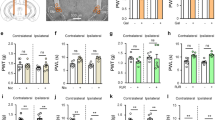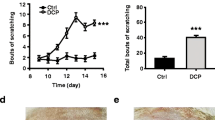Abstract
Acetylcholine (ACh) regulates pain perception in the central nervous system. However, the mechanism of action of ACh on pain-related neurons in the hippocampal CA3 is not clear. The present study aimed to determine the effect of ACh, muscarinic ACh receptors (mAChRs) agonist pilocarpine and mAChRs antagonist atropine on the pain-evoked responses of pain-excited neuron (PEN) and pain-inhibited neuron (PIN) in the hippocampal CA3 of normal rats. The trains of electric impulses applied to the sciatic nerve were used as noxious stimulation. The electric activities of PEN or PIN in the hippocampal CA3 were recorded by using a glass microelectrode. Our results showed that, in the hippocampal CA3, the intra-CA3 microinjection of ACh (2 μg/1 μl) or pilocarpine (2 μg/1 μl) decreased the discharge frequency and prolonged firing latency of PEN, and increased the discharge frequency and shortened firing inhibitory duration (ID) of PIN, i.e. exhibiting the analgesic effect of ACh or pilocarpine. The intra-CA3 administration of atropine (0.5 μg/1 μl) produced an opposite effect. On the basis of the above-mentioned findings, we can deduce that ACh and mAChRs in the hippocampal CA3 are involved in the modulation of nociceptive response by regulating the electric activities of PEN and PIN.




Similar content being viewed by others
References
Bian JT, Sun MZ, Han JS (1993) Reversal of electroacupuncture tolerance by CCK-8 antiserum: an electrophysiological study on pain-related neurons in nucleus parafascicularis of the rat. Int J Neurosci 72:15–29
Bird CM, Burgess N (2008) The hippocampus and memory: insights from spatial processing. Nat Rev Neurosci 9:182–194
Brown MW, Aggleton JP (2001) Recognition memory: what are the roles of the perirhinal cortex and hippocampus? Nat Rev Neurosci 2:51–61
Buño W, Cabezas C, de Fernández Sevilla D (2006) Presynaptic muscarinic control of glutamatergic synaptic transmission. J Mol Neurosci 30:161–164
Chen SR, Wess J, Pan HL (2005) Functional activity of the M2 and M4 receptor subtypes in the spinal cord studied with muscarinic acetylcholine receptor knockout mice. J Pharmacol Exp Ther 313:765–770
Duvernoy HM (2005) The human hippocampus. Springer, Berlin
Frazier CJ, Strowbridge BW, Papke RL (2003) Nicotinic receptors on local circuit neurons in dentate gyrus: a potential role in regulation of granule cell excitability. J Neurophysiol 89:3018–3028
Ghelardini C, Galeotti N, Bartolini A (2000) Loss of muscarinic antinociception by antisense inhibition of M1 receptors. Br J Pharmacol 129:1633–1640
Guizzetti M, Moore NH, Giordano G, Costa LG (2008) Modulation of neuritogenesis by astrocyte muscarinic receptors. J Biol Chem 283:31884–31897
Halgren E, Walter RD, Cherlow DG, Crandall PH (1978) Mental phenomena evoked by electrical stimulation of the human hippocampal formation and amygdala. Brain 101:83–117
Hebben N, Corkin S, Eichenbaum H, Shedlack K (1985) Diminished ability to interpret and report internal states after bilateral medial temporal resection: case H.M. Behav Neurosci 99:1031–1039
Jiao RS, Yang CX, Zhang Y, Xu MY, Yang XF (2009) Cholinergic mechanism involved in the nociceptive modulation of dentate gyrus. Biochem Biophys Res Commun 379:975–979
Khanna S, Zheng F (1999) Morphine reversed formalin-induced CA1 pyramidal cell suppression via an effect on septohippocampal neural processing. Neurosci 89:61–71
Kremin T, Hasselmo ME (2007) Cholinergic suppression of glutamatergic synaptic transmission in hippocampal region CA3 exhibits laminar selectivity: implication for hippocampal network dynamics. Neuroscience 149:760–767
Li B, Duysen EG, Volpicelli-Daley LA, Levey AI, Lockridge O (2003) Regulation of muscarinic acetylcholine receptor function in acetylcholinesterase knockout mice. Pharmacol Biochem Behav 74:977–986
McKenna JE, Melzack R (2001) Blocking NMDA receptors in the hippocampal dentate gyrus with AP5 produces analgesia in the formalin pain test. Exp Neurol 172:92–99
Mojtahedin A, Tamaddonfard E, Zanbouri A (2009) Role of central muscarinic cholinergic receptors in the formalin-induced pain in rats. Indian J Pharmacol 41:144–147
Navarrete M, Araque A (2010) Endocannabinoids potentiate synaptic transmission through stimulation of astrocytes. Neuron 68:113–126
Nogueira-Neto FS, Amorim RL, Brigatte P, Picolo G Jr, Ferreira WA, Gutierrez VP, Conceicão IM, Della-Casa MS, Takahira RK, Nicoletti JL, Cury Y (2008) The analgesic effect of crotoxin on neuropathic pain is mediated by central muscarinic receptors and 5-lipoxygenase-derived mediators. Pharmacol Biochem Behav 91:252–260
Pellegrino LJ, Pellegrino AS, Cushmanl AJ (1979) A stereotaxic atlas of the rat brain, 2nd edn. Plenum Press, New York, pp 81–84
Roland JJ, Savage LM (2009) Blocking GABA-A receptors in the medial septum enhances hippocampal acetylcholine release and behavior in a rat model of diencephalic amnesia. Pharmacol Biochem Behav 92:480–487
Shi TF, Yang CX, Yang DX, Jiao RS, Zhang GW, Gao HR, Zhang D, Xu MY (2010) MK-801 changes the role of glutamic acid on modulation of algesia in nucleus accumbens. Biochem Biophys Res Commun 395:407–411
Sun MZ, Chen LS, Gu HL, Cheng J, Yue LS (1980) Effect of acupuncture on unit discharge in nucleus parafascicularis of rat thalamus. Sheng li Xue Bao 32:207–213
Szabadics J, Varga C, Brunner J, Chen K, Soltesz I (2010) Granule cells in the CA3 area. J Neurosci 30:8296–8307
van Strien NM, Cappaert NLM, Witter MP (2009) The anatomy of memory: an interactive overview of the parahippocampal–hippocampal network. Nat Rev Neurosci 10:272–282
Vizi ES, Kiss JP (1998) Neurochemistry and pharmacology of the major hippocampal transmitter systems: synaptic and nonsynaptic interactions. Hippocampus 8:566–607
Xiao Y, Yang XF, Xu MY (2007) Effect of acetylcholine on pain-related electric activities in hippocampai CA1 area of normal and morphinistic rats. Neurosci Bull 23:323–328
Yaksh TL, Dirksen R, Harty GJ (1985) Antinociceptive effects of intrathecally injected cholinomimetic drugs in the rat and cat. Eur J Pharmacol 117:81–88
Yang XF, Xiao Y, Xu MY (2008) Both endogenous and exogenous ACh plays antinociceptive role in the hippocampus CA1 of rats. J Neural Transm 115:1–6
Zhang XT (1973) The integration of thalamus in the process of acupuncture analgesia. Sci China 1:28–52
Zhang HL, Han R, Chen ZX, Chen BW, Gu ZL, Reid PF, Raymond LN, Qin ZH (2006) Opiate and acetylcholine-independent analgesic actions of crotoxin isolated from crotalus durissus terrificus venom. Toxicon 48:175–182
Zhang Y, Yang CX, Xu XZ, Jiao RS, Jin HB, Lv YH, Yang HK, Xu MY (2008) Morphine dependence changes the role of droperidol on pain-related electric activities in caudate nucleus. Biochem Biophys Res Commun 372:179–185
Zhang W, Tan YF, Atwood HL, Martin Wojtowicz J (2010) Biphasic effects of the cholinergic agonist carbachol on long-term potentiation in the dentate gyrus of the mammalian hippocampus. Neurosci Lett 479:157–160
Zhao XY, Liu MG, Yuan DL, Wang Y, He Y, Wang DD, Chen XF, Zhang FK, Li H, He XS, Chen J (2009) Nociception-induced spatial and temporal plasticity of synaptic connection and function in the hippocampal formation of rats: a multi-electrode array recording. Mol Pain 5:55–61
Acknowledgments
This work was supported by National Natural Science Foundation of China (Grant No. 30240058), Tackle Key Problems in Science and Technology Item of Heilongjiang Province in China (Grant No. GC05C40607) and Natural Science Foundation of Heilongjiang Province in China (Grant No. D200936).
Author information
Authors and Affiliations
Corresponding authors
Rights and permissions
About this article
Cite this article
Li, GZ., Liang, QC., Jin, YH. et al. The effect of acetylcholine on pain-related electric activities in the hippocampal CA3 of rats. J Neural Transm 118, 555–561 (2011). https://doi.org/10.1007/s00702-010-0545-x
Received:
Accepted:
Published:
Issue Date:
DOI: https://doi.org/10.1007/s00702-010-0545-x




